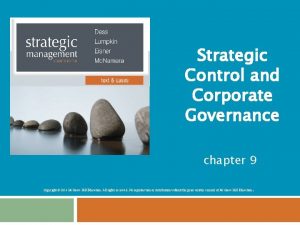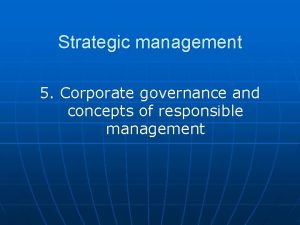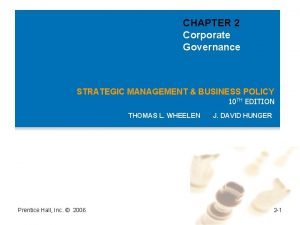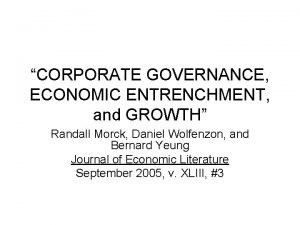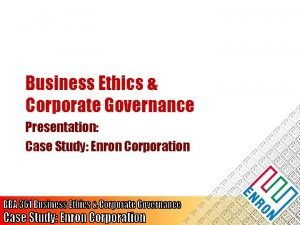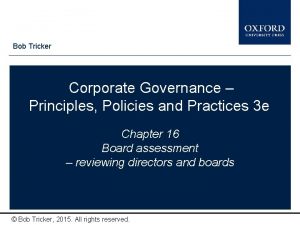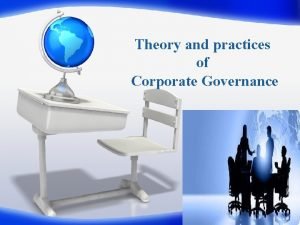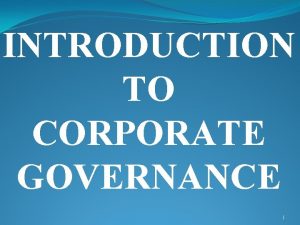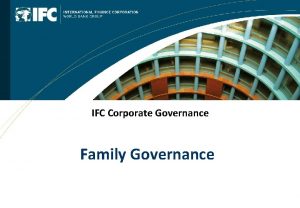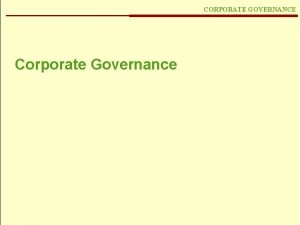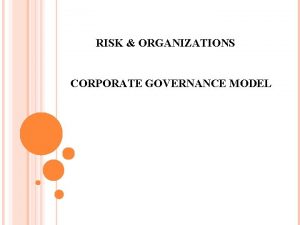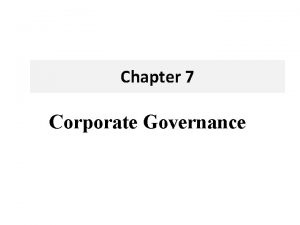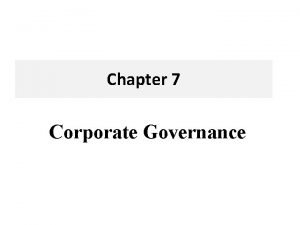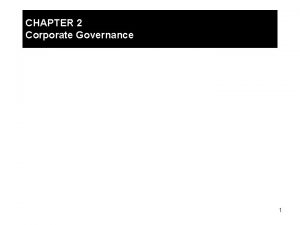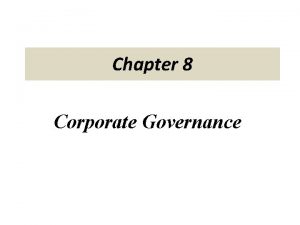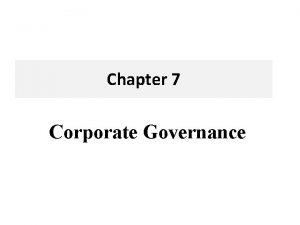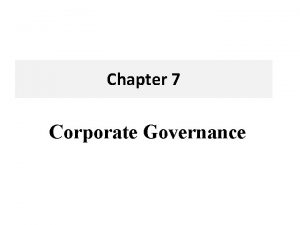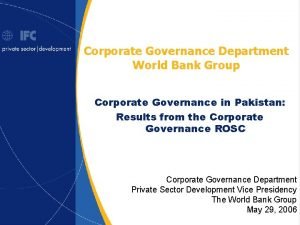Strategic Control and Corporate Governance chapter 9 Copyright
















- Slides: 16

Strategic Control and Corporate Governance chapter 9. Copyright © 2014 Mc. Graw-Hill Education. All rights reserved. No reproduction or distribution without the prior written consent of Mc. Graw-Hill Education

Strategic Control 9 -2 ¥ Strategic control involves monitoring performance toward strategic goals and taking corrective action when needed via effective systems: © Informational control systems © Behavioral control systems © Corporate governance

Strategic Control: Traditional Approach 9 -3 ¥ The traditional approach to strategic control is sequential © Strategies are formulated, goals are set © Strategies are implemented © Performance is measured against goals Exhibit 9. 1 Traditional Approach to Strategic Control

Strategic Control: 9 -4 Contemporary Approach ¥ Relationships between strategy formulation, implementation, & control are highly interactive, utilizing © Informational control © Behavioral control Exhibit 9. 2 Contemporary Approach to Strategic Control

Informational Control 9 -5 ¥ Informational control deals with both the internal & external environment ¥ Do the organization’s goals and strategies still “fit” within the context of the current strategic environment? ¥ Two key issues: © Scan & monitor the external environment © Continuously monitor the internal environment

Behavioral Control 9 -6 ¥ Behavioral control = focused on implementation – “doing things right” ¥ Influences the actions of employees via: © Culture © Rewards © Boundaries Exhibit 9. 3 Essential Elements of Behavioral Control

Behavioral Control: Culture 9 -7 ¥ Organizational culture is a system of ¥ Organizational culture shapes a firm’s © Shared values (what is important) © Beliefs (how things work) © People © Organizational structures © Control systems ¥ Organizational © Behavioral culture produces norms (the way we do things around here)

Behavioral Control: Rewards 9 -8 ¥ Reward systems & incentive programs: © Powerful means of influencing an organization’s culture © Focus efforts on high-priority tasks © Motivate individual & collective task performance © Can be an effective motivator & control mechanism

Behavioral Control: Boundaries 9 -9 ¥ Boundaries © Focusing and constraints can be useful individual efforts on strategic priorities © Providing short-term objectives and action plans to channel efforts Specific, measurable, including a specific time horizon for attainment Achievable, yet challenging enough to motivate Individual managers held accountable for implementation

Corporate Governance 9 -10 ¥ Corporate governance controls focus on relationships between © The shareholders © The management (led by the Chief Executive Officer - CEO) © The Board of Directors ¥ How can corporations succeed (or fail) in aligning managerial motives with © The interests of the shareholders © The interests of the board of directors

Corporate Governance 9 -11 ¥ The separation of owners (shareholders) & management in a modern corporation © Shareholders (investors) have limited liability & can participate in the profits without taking direct responsibility for operations © Management can run the company without personally providing any funds © The Board of Directors are elected by shareholders & have a fiduciary obligation to protect shareholder interests

9 -12 Corporate Governance: Agency Theory ¥ Agency theory deals with the relationship between principals & agents ¥ What to do when the goals of the principals and agents conflict? ¥ What to do when it is difficult or expensive for the principal to verify what the agent is actually doing? ¥ What happens when the principal and the agent have different attitudes and preferences toward risk?

Corporate Governance Mechanisms 9 -13 ¥ Corporate governance mechanisms: aligning the interests of owners and managers through ©A committed and involved Board of Directors © Shareholder activism © Managerial rewards and incentives Contract-based outcomes CEO duality – should the CEO also be chairman of the board of directors?

Corporate Governance Mechanisms 9 -14 ¥ External © The governance control mechanisms market for corporate control The takeover constraint © Auditors Enron, © Banks World. Com? and analysts Lehman Brothers, Countrywide? © Regulatory Securities bodies and Exchange Commission (SEC) The Sarbanes-Oxley Act © Media and public activists Bloomberg Businessweek, Ralph Nader

9 -15 International Corporate Governance ¥ Principal – principal conflicts (vs principal – agent conflicts) involve © Concentrated Motivation ownership, or family ownership to engage in expropriation of minority shareholders for personal gain © Business action groups who can take coordinated Japanese © Few keiretsus, Korean chaebols external regulatory constraints

9 -16 International Corporate Governance Exhibit 9. 9 Principal-Agent Conflicts and Principal-Principal Conflicts: Diagram Source: Young, M. N. , Peng, M. W. , Ahlstrom, D. , Bruton, G. D. , & Jiang, 2008. Principal-Principal Conflicts in Corporate Governance. Journal of Management Studies 45(1): 196 -220; and Peng, M. V. 2006. Global Strategy. Cincinnati: Thomson South-Western. We are very appreciative of the helpful comments of Mike Young of Hong Kong Baptist University and Mike Peng of the University of Texas at Dallas. A
 Role of corporate governance in strategy formulation
Role of corporate governance in strategy formulation Objective of corporate governance
Objective of corporate governance Corporate governance chain
Corporate governance chain Corporate governance in strategic management
Corporate governance in strategic management Corporate governance strategic management
Corporate governance strategic management Examples of agency problems
Examples of agency problems Corporate social responsibility and good governance
Corporate social responsibility and good governance Insider system of corporate governance
Insider system of corporate governance Corporate governance and economic growth
Corporate governance and economic growth Enron presentation
Enron presentation Tricker corporate governance
Tricker corporate governance Sociological theory of corporate governance
Sociological theory of corporate governance Corporate governance definitie
Corporate governance definitie Isu dan riset kontemporer corporate governance
Isu dan riset kontemporer corporate governance Introduction of corporate governance
Introduction of corporate governance Ifc corporate governance
Ifc corporate governance Corporate governance in sri lanka
Corporate governance in sri lanka
